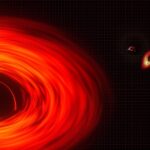A new discovery states that exoplanets are hiding behind the Neptune ridge. This discovery tells us we still don’t know much about our solar system.
The Neptunian ridge is a newly identified feature in the distribution of Neptune-sized exoplanets. It sits between two distinct regions: the Neptunian desert and the Neptunian savanna.
The Neptunian desert is a region close to stars where Neptune-sized planets are scarce. This scarcity is due to intense stellar radiation stripping away their atmospheres. On the other hand, the Neptunian savanna is a region further out where these planets are more commonly found.
Astronomers from the University of Geneva, the National Centers of Competence in Research (NCCR) Planets group, and the Centro de Astrobiología (CAB) made this discovery.
They found an overdensity of planets in this region, indicating a sharp transition between the barren Neptunian desert and the more populated Neptunian savanna.
The Neptunian ridge marks a critical zone where planets have managed to migrate inward while resisting intense radiation near their stars. This discovery was made possible by analyzing data from NASA’s Kepler mission. Advanced statistical techniques were used to correct for observational biases.
The Neptunian desert has long puzzled astronomers. It points to strange quirks in the evolution of planetary systems. The discovery of the Neptunian ridge adds a new layer to this mystery. It shows that there is a sharp transition between the desert and the savanna. This transition zone is where planets have managed to survive the harsh conditions near their stars.
Understanding the Neptunian ridge is crucial for exoplanet research. It helps scientists learn more about the dynamics that influence the formation and evolution of close-in exoplanets. The ridge is a region where planets have migrated inward but have not been stripped of their atmospheres. This makes it a unique area for studying planetary migration and survival.
The discovery of the Neptunian ridge also has implications for the search for habitable planets. Planets in this region may have conditions that allow them to retain their atmospheres. This could make them potential candidates for habitability. The ridge could be a key area to focus on in the search for life beyond our solar system.
The Neptunian ridge is not just a scientific curiosity. It is a critical piece of the puzzle in understanding planetary formation and migration. The discovery of this feature shows that there is still much to learn about the dynamics of exoplanetary systems. It also highlights the importance of continued exploration and study of these distant worlds.




